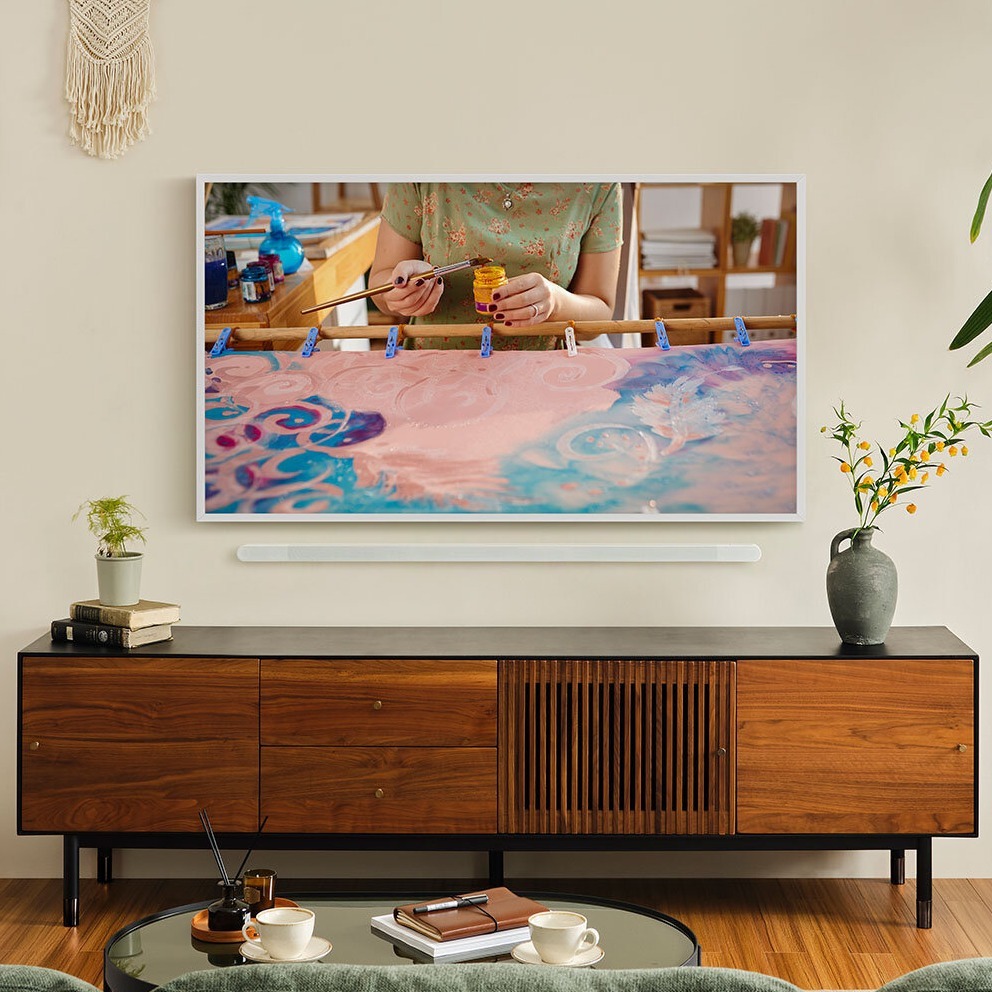
TV, Audio & Electronics
From movies and music to streaming and gaming, let's talk TV, tech and home entertainment!
TV, AUDIO & ELECTRONICS | 4 JUNE, 2024
7 MIN READ
Your guide to Smart TVs
When did the 'idiot box' get so smart?
If your old TV is on the blink and you're looking for a new gogglebox, you might have some questions about today's smart TVs. When you have technology questions, Appliances Online has answers! Here's a quick, handy guide to smart TVs.

What is a smart TV?
A smart TV is a television with advanced built-in digital connectivity, allowing it to access streaming content from the internet as well as connect to other devices like smartphones, tablets, smart home hubs and virtual assistants.
This integrated connectivity lets you enjoy fully immersive and interactive home entertainment that goes far beyond just watching broadcast or cable channels. The latest Smart TVs aim to be the central hub for all your digital content, communication, and smart home needs.
Is a smart TV a digital TV?
Yes, all modern TVs are digital.
As Australian TV networks completely switched over to digital broadcasting many years ago, any new television you buy will be able to access your area’s digital channels – you don’t need to buy a smart TV just for this. However, almost all digital TVs are now smart anyway (you'd have to hunt pretty hard to find one of the few digital TVs that aren't also smart).
What can a smart TV do for me?
A smart TV can let you watch telly, but it can do a lot more than that. Features and benefits include:
4K resolution and higher - Most of today's smart TVs have incredibly lifelike 4K resolution, and some even have 8K resolution (though the TV can only display content in this resolution if it has been created and delivered at this resolution)
Incredible display technology - Display technology varies from standard LED to next-gen OLED (Organic LED), QLED (Quantum Dot LED) and MicroLED displays, which enable exceptional contrast, depth of colour and smooth motion
Built-in streaming and cloud gaming - Enjoy the latest shows, movies, music, and games without additional devices
Voice Assistants - Control your TV and smart home with natural language voice commands
VR and AR Capabilities - Immersive experiences with virtual and augmented reality features
Automatic AI Personalisation - Some models adjust settings and recommendations based on user preferences
Does a smart TV require special connection?
Smart TVs need to connect to the internet to access online content and services. This can be done through wifi or ethernet.
DLNA and similar networking standards are now commonplace, making it easy to share content between your Smart TV and other compatible devices in your home.
How to use a smart TV
Smart TV interfaces have evolved to be incredibly intuitive and user-friendly. Not every TV will have all these features, but they are becoming more commonplace.
Advanced voice control - Have natural conversations with your TV to find content, get answers, and control devices
Gesture and motion control - Some TVs use built-in cameras and sensors to detect and interpret hand gestures and body movements
Automatic user recognition - Some TVs will recognise you either by sight or by sound and adjust settings to your personal preferences
Smartphone and tablet integration - Use your mobile devices as remote controls, content sources, and secondary displays
Do I need a smart TV?
This question is almost redundant now, because if you need a new TV, it will almost certainly have smart capabilities. Whether you choose to use them or not is up to you.
For most people, the question is how smart you want your new telly to be - and of course, the most advanced TVs will tend to have the higher price tags.
Entry-level smart TVs cover the basics, but today's basics are far from basic when compared with the capabilities of the TVs of old.
It's worth noting that most TVs run on one of a handful of operating systems.
Android TV (Sony, Hisense, TCL, and others)
WebOS (LG)
Tizen (Samsung)
A $700 and $3,000 TV from the same brand running the same operating system will tend to share the same core smart features. The higher priced model, though, may have faster, smoother operation and a larger storage capacity.
Most of the higher price tag of premium models, though, is accounted for by more advanced display technology, higher resolution and larger screen size.
For most people, a mid-range 4K TV will be packed with all the smart functionality needed for intuitive and immersive viewing or gaming.
Smart TV vs Non-Smart TV Comparison Table
Feature | Smart TV | Non-Smart TV (Standard/Digital TV) |
|---|---|---|
Internet Access | Yes - via Wi-Fi or Ethernet | No |
Streaming Apps | Yes - Netflix, YouTube, Stan, Disney+, etc. | No |
Voice Control / AI | Available on most 2025 models | Not supported |
Built-in Operating System | Yes (e.g. Google TV, Tizen, webOS) | No OS |
Remote App Control | Yes (via smartphone apps) | No |
Web Browsing | Yes | No |
Software Updates | Yes - Over-the-Air | No |
Best For | Streaming, gaming, smart home integration | Basic broadcast TV, second-room use |
Get your new smart TV sooner with Free Delivery*
We deliver smart TVs, and the rest of our products, to 95% of Australia’s population with Appliances Online's legendary FREE delivery* - and we can usually get your new telly to you by the next day (Mon-Fri) if it’s in stock. Most stores don’t offer this, so if you’re comparing prices, always factor in the other retailer’s delivery cost and how long it will take to get to you. PLUS, if you’re getting rid of an old TV, we’ll happily take it away for recycling when we deliver your new one.
You can view a huge range of smart TVs here, or if you want to find out more about LCD, HDR and LED TV, or any other details to help you choose the best TV for your home, read our TV Buying Guide or call or message us any time of the day or night on 1300 004 500.
Smart TV Frequently Asked Questions (FAQ)
FAQ | Answer |
|---|---|
What is a Smart TV? | A Smart TV is a television that connects to the internet and offers built-in apps for streaming, web browsing, gaming, and voice control. It's like a TV and a tablet combined - no extra boxes needed. |
What’s the difference between a Smart TV and a regular TV? | A regular TV (non-smart or digital TV) can only show broadcast content or whatever device you plug into it. A Smart TV, on the other hand, comes pre-loaded with apps like Netflix, YouTube, and supports Wi-Fi, Bluetooth, and even smart home assistants. |
Why get a Smart TV in 2025? | With most Aussie households relying on streaming services, a Smart TV is practically essential. It lets you watch catch-up TV (like ABC iView or SBS On Demand), connect to smart devices, and even use AI to get personalised recommendations. |
What can you do with a Smart TV? | You can stream TV shows and movies, browse the internet, check the weather, cast content from your phone, play games, run fitness apps, attend Zoom calls, and much more — all on your TV screen. |
Do Smart TVs still have free-to-air channels? | Yes, Smart TVs include standard digital tuners, meaning you can still watch your local free-to-air channels like Channel 7, 9, 10, ABC, and SBS - and often use their on-demand apps too. |
What operating systems do Smart TVs use? | Different brands use different Smart TV platforms: |
Is it hard to set up a Smart TV? | Not at all. Most Smart TVs guide you through setup with an easy on-screen wizard. All you need is a Wi-Fi connection (or Ethernet cable) and a Google or Samsung/LG account, depending on the brand. |
Can I turn a normal TV into a Smart TV? | Yes! Devices like Chromecast, Apple TV, Fire TV Stick, or Fetch can plug into your regular TV's HDMI port and turn it into a fully functional Smart TV. Learn more about how to make a TV a Smart TV HERE. |

After joining Appliances Online, Mark learned more than he ever expected to know about washers, dryers and fridges, and discovered a knack for solving everyday problems using typical household appliances. When he’s not toiling at his day job, Mark tries to find time to write the next bestseller and draw satirical cartoons, but is too easily distracted by TV, music and video games.
Latest Articles
KITCHEN
1 JANUARY 2026
Our Top 10 best selling top mount fridges in Australia 2025
Your shortcut to finding the perfect top mount fridge.
KITCHEN
30 DECEMBER 2025
4 ways to make your water and ice taste better
Purer, cleaner-tasting drinks, made simple
HOME LIVING+
30 DECEMBER 2025
How to choose the best exercise equipment for a home gym
Happy 2026! Let's make it a healthy one.
LAUNDRY
26 DECEMBER 2025
5 of the best Boxing Day Sale 2025 Deals at Appliances Online
Refresh for less and start 2026 right!
More Like This
KITCHEN
1 JANUARY 2026
Our Top 10 best selling top mount fridges in Australia 2025
Your shortcut to finding the perfect top mount fridge.
KITCHEN
30 DECEMBER 2025
4 ways to make your water and ice taste better
Purer, cleaner-tasting drinks, made simple
HOME LIVING+
30 DECEMBER 2025
How to choose the best exercise equipment for a home gym
Happy 2026! Let's make it a healthy one.




